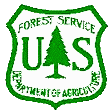
Chapter 4
Ecological Subregions of the United
States
| Back |  |  Contents |  | Forward |
 | Chapter 4 |
|
Brooks Range Tundra - Polar Desert
Two Sections have been delineated in this Province:M121A--Foothills
M121B--MountainsThey are in northern Alaska, north of the Arctic Circle. The area of these Sections is about 101,600 mi2 (263,100 km2).
Section M121A--Foothills
Geomorphology. In the northern portion, rock folding and unequal erosion have produced a linear-ridge topography. The sedimentary rocks of the southern portion are tightly folded and form irregular buttes, mesas, and long linear ridges. Hummocky morainal ridges border most north-south valleys. Ice-related features are common (e.g., pingos, solifluction lobes, ice-wedge polygons, stone stripes). The area consists of maturely dissected low hills and ridges that have never been glaciated. Elevation is mainly less than 1,970 ft (600 m).Lithology and Stratigraphy. The entire area lies within the North Slope-Endicott Mountain subterrane, consisting of shale, conglomerate, carbonate, and deep shelf marine rocks of Permian to lower Mesozoic age. The origin of the deep sediments is thought to be the floor of the Beaufort Sea.
Soil Taxa. The dominant soils are Aquepts that have a pergelic temperature regime, mainly Pergelic Cryaquepts, Histic Pergelic Cryaquepts and Pergelic Ruptic-Histic Cryaquepts.
Potential Natural Vegetation. Moist tundra-cottongrass tussocks are interspersed with willow-dominated communities along river corridors. Fauna. Moist tundra communities provide nesting habitat for several species of sandpiper (e.g., Baird's, stilt, and buff-breasted) and small mammals such as the insular vole. Willow ptarmigan and Alaskan hare inhabit the scattered patches of birch, alder, and willow. Predators include rough-legged hawks, peregrine falcons, gyrfalcons, snowy owls, and Arctic foxes. Wood frogs have been reported north of the Brooks Range. Arctic char and Arctic grayling are found in most rivers and some of the shallow tundra lakes.
Climate. Average annual precipitation ranges from 6 to 10 in (150 to 250 mm). Average annual temperature ranges from 9 to 20 _o_F (-13 to -7 _o_C). The growing season is generally from June 15 to August 1; however, frosts may occur in any month.
Surface Water Characteristics. Many swift streams and rivers occur among the hills, but lakes are infrequent. Most streams have swift, braided courses across gravel flats. Streams often freeze solid to their bottoms, causing floods to occur over the surrounding flats. The entire area is underlain by permafrost; consequently, soils are fairly wet. Some thaw lakes are present. Wetlands occupy greater than 83 percent of the area. Disturbance Regimes. Occurrence of wildfire is very low.
Land Use. Climate and soils are unsuitable for agriculture. Subsistence hunting and fishing is present. There is limited petroleum extraction.
Cultural Ecology. Inupiaq Eskimos reside in this section.
Compiled by Alaska Region.
Top
Section M121B--Mountains
Geomorphology. Rugged, deeply dissected, east-west trending mountains having rounded-to-sharp summits. Abrupt mountain fronts frequently face northward. Small cirque glaciers occur only on the highest peaks of the Brooks Range. Elevation ranges from 1,640 to 8,530 ft (500 to 2,600 m).Lithology and Stratigraphy. The area is composed of segments of Endicott Mountain, the North Slope, and Delong Mountain subterranes and the Hammond terrane. These are continental fragments, some of which have been faulted, folded, and metamorphosed.
Soil Taxa. The dominant soils are Entisols and Inceptisols that form in a pergelic temperature regime, specifically Lithic Cryorthents, Pergelic Cryaquepts, and Pergelic Cryumbrepts.
Potential Natural Vegetation. Many of the highest ridges are barren or ice-covered. Alpine tundra heath communities occur on upper and intermediate slopes, whereas moist tundra sedge-tussock meadows with occasional trees prevail on lower slopes. Shrub thickets occur along river corridors.
Fauna. Golden eagles inhabit the expansive subalpine mountain valleys and alpine tundra of this Section. Horned larks, Smith's longspurs, and insular voles are characteristic inhabitants of the wide valley floors. Dall sheep occur in the alpine zone. Ground water springs and associated Arctic rivers of the Brooks Range support populations of Arctic char.
Climate. Average annual precipitation ranges from 6 to 13 in (150 to 330 mm). Average annual temperatures varies from 10 to 22 _o_F (-12 to -6 _o_C). The growing season generally extends from June 15 to August 1. Freezing temperatures may occur in any month.
Surface Water Characteristics. Several glacially-carved lakes are at the northern and southern peripheries. Most streams and rivers flow through narrow ravines with steep headwalls and together form a broad dendritic pattern. All soils, except for a few south-facing slopes, are underlain by permafrost. Wetlands occupy at least 20 percent of the area.
Disturbance Regimes. Wildfire is a fairly common disturbance event.
Land Use. The area is largely undisturbed by humans, except for occasional subsistence use during summer months. Cultural Ecology. Inupiaq Eskimos reside in the west and the Kutchin Athabaskan Mountains in the east.
Compiled by Alaska Region.
Top
Back
ContentsForward